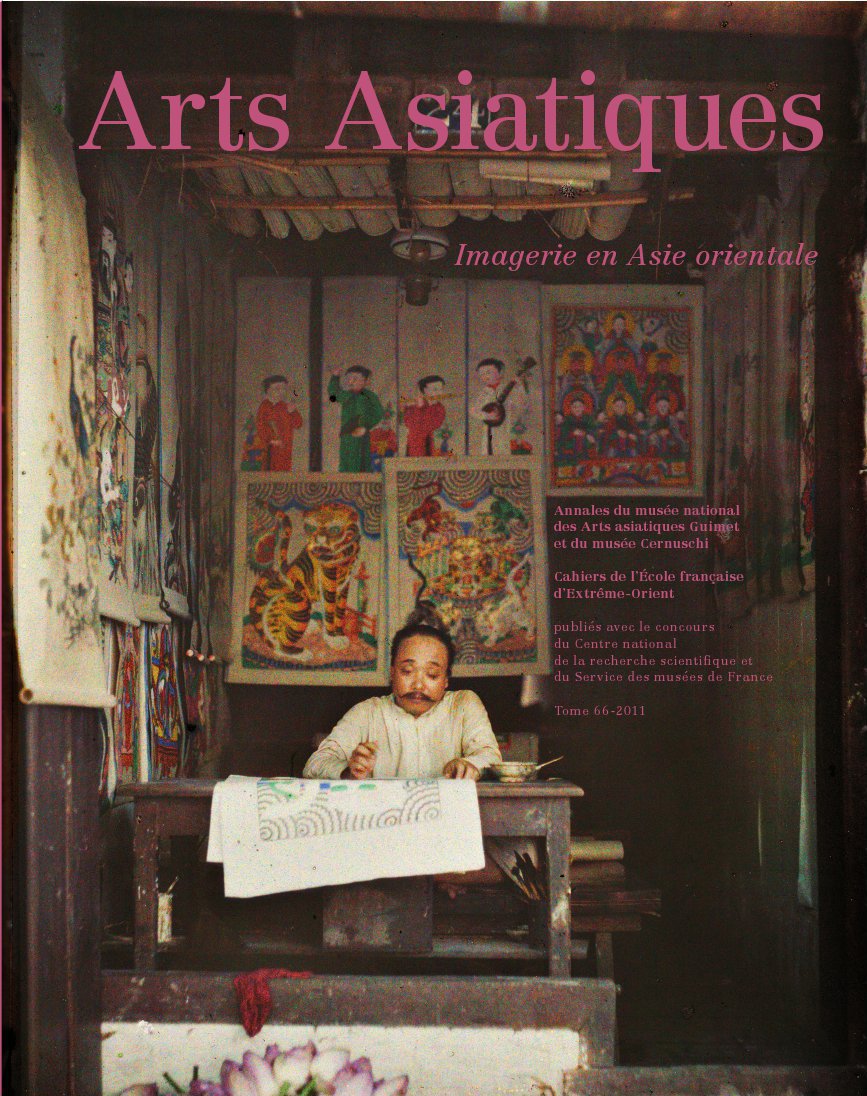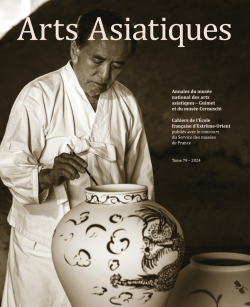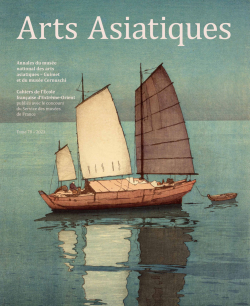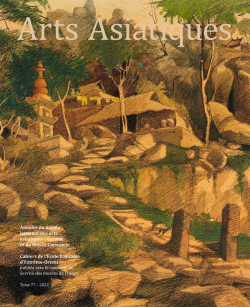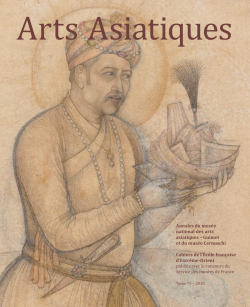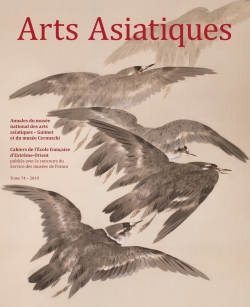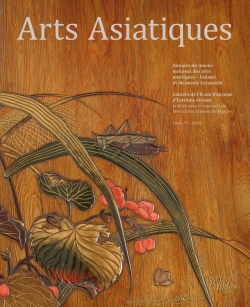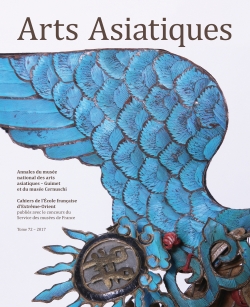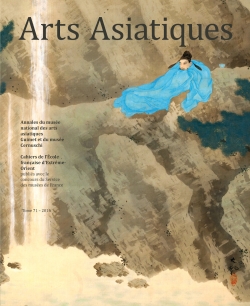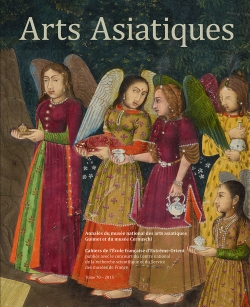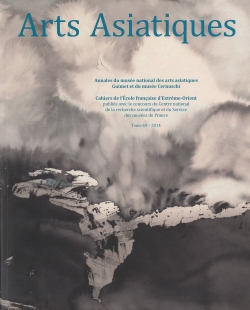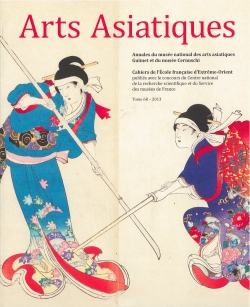The catalog of EFEO Publications includes works on a wide range of disciplines in the humanities and social sciences (archaeology, history, anthropology, literature, philology, etc.), centered on Asia, from India to Japan.
These publications address both specialists, and a wider public interested in Asian civilizations and societies.
Arts Asiatiques 66 (2011)
Imagerie en Asie orientale
Collection : Arts Asiatiques
Collection's number: 66
Editor: Schmid (Charlotte), Debaine-Francfort (Corinne)
Edition: EFEO, Musée Guimet
Publication date: 2011
Status : Available
40,00 €
ISBN-13 : 9782855391564
ISSN : 0004-3958
Width : 22 cm
Height : 27 cm
Weight : 1,4 kg
Number of pages : 269
Distributor : EFEO Diffusion
Geography : Vietnam, Asia, China, Japan
Language : French, English, Japanese
Place : Paris
Support : Papier
Table of contents
Du sacré au quotidien
* Alain Arrault, Les calendriers chinois : l'image du temps, le temps dans les images
* Michela Bussotti, Images familières, images familiales : imprimés de la Chine rurale (XVe-XIXe siècle)
* Christophe Marquet, Figures divines et démoniaques : les Ōtsu-e, peintures populaires japonaises de l'époque d'Edo
* James Flath, Social Narratives in Yangliuqing Nianhua of the 1930s
* Philippe Papin, La diversité de l'imagerie vietnamienne et les figures de la vie ordinaire
* Olivier Tessier, Du geste au dessin - la vie à Hà-Nội au début du XXe siècle saisie par Henri Oger
De l'artisanat à l'art
* J. S. Edgren, Late-Ming Erotic Book Illustrations and the Origins of Ukiyo-e Prints
* Takagi Gen, L'illustration des romans populaires au Japon aux XVIIIe et XIXe siècles
* Hélène Bayou, Du Japon à l'Europe, changement de statut de l'estampe ukiyo-e
* François Lachaud, Les provinces de la nuit : quelques nocturnes de Kobayashi Kiyochika (1847-1915)
Publicité et Propagande
* Julien Faury, Mourir en scène : les portraits nécrologiques d'acteurs de kabuki au milieu du XIXe siècle
* Anne Kerlan, De la "qipao" au col Mao : richesse visuelle et thématique des magazines de cinéma chinois de la première moitié du XXe siècle
* Francesca Dal Lago, Les racines populaires de l'art de la propagande communiste en Chine : des gravures sur bois du Mouvement pour la nouvelle xylographie (xinxin banhua 新新版畫) aux nouvelles estampes du Nouvel An (xin nianhua 新年畫)
* Nora Annesley Taylor, De la parodie à la propagande La résistance anticoloniale vue par les graphistes vietnamiens à partir des années 1950
About the collection
Arts Asiatiques
Founded in 1924 under the title Revue des Arts Asiatiques, the journal was placed under the directorship of Jean Filliozat, a member of the Academy of Inscriptions and Belles-Lettres and director of the Ecole française d'Extrême-Orient (EFEO), in 1959. Since 1962 Arts Asiatiques has been published by the EFEO, in association with the Guimet and Cernuschi Museums and with the financial support of the Centre National de la Recherche Scientifique (CNRS).
From the outset, Arts Asiatiques was conceived as bridging the worlds of academia and the museum. Today, Arts Asiatiques remains one of the rare periodicals devoted to Asian art and archaeology from a rigorously scholarly perspective. Its ambition is to publish all fields of original scholarship and technical expertise and to explore the full range of primary sources useful to the comprehensive analysis of works of art, from their fabrication and transmission to their iconographic impact: archaeology, history of art and religions, social history, anthropology, material culture, architecture, conservation, textual and documentary sources including inscriptions on various media.
The Editors
The editorial team of Arts Asiatiques comprises the Editor-in-Chief, an Editorial Board based in Paris, and an international Advisory Board. See the list of members
Editorial Office
ARTS ASIATIQUES
Musée national des arts asiatiques - Guimet
6, place d'Iéna
75116 PARIS
arts.asiatiques@efeo.net
Download the instructions to the authors [PDF]
About the editor
Schmid (Charlotte)
Archaeology of the Indian world
The scientific life of Charlotte Schmid is marked by her stays in India: two years in North India (1991-1993) were followed by an assignment, in September 1999, in the centre of Pondicherry (EFEO), Tamil Nadu, for four years. These two periods of intensive work in India articulate a research led between two spaces of field-work, the North and the South of the subcontinent.
After an attempt to define a colonial culture, the Bactrian Greece, based on the material from Aï Khanum -the most important Greek colony excavated in Central Asia- and classical studies (Greek, Latin, École du Louvre), the discovery of Sanskrit and the reading of La grande route de Bactres à Taxila of Alfred Foucher, pointed to the necessity of field-work.
Firstly, following the road of India to an accessible country, which allows studying the relationships between two types of corpus, texts and archaeological material taken in a broad sense, Charlotte Schmid worked on the first known figures of a major Hindu deity of bhakti, Kṛṣṇa in Mathurā. Today an Indian city of medium size of which Kṛṣṇa-devoted cults have forged cultural identity, Mathurā, with its mosque of the 17th c. and its numerous Jain, Buddhist and Brahmanical remains dated from the 2d c. BC, is loaded with myth. A doctoral thesis supervised by Gérard Fussman and focusing on a confrontation between the archaeological evidence and the texts which made of Kṛṣṇa “the” child of Mathurā, was followed by a research on the iconography and the epigraphy of the Gupta period, as it is accounted for in Le don de voir.
Secondly, the posting in Pondicherry led C. Schmid to study the appearance of the deities of bhakti in the Tamil country. The issue of the relationship between texts and archaeology is conducted in "another" region and on better documented periods of time. The EFEO centre gave access to new fields of research. The work with traditional pundits was not the least of them and C. Schmid started to also investigate Tamil data.
Posted in Paris since 2003, she pursues researches on the figures of Hinduism in Ancient India, fed by lively exchanges with the Indian scholars of the Centre of Pondichéry and by archaeological material (monuments, sculptures, inscriptions). Temples in situ, provided with dozens of inscriptions and sculptures, established between the 6th and the 12th c., as well as the texts, often devotional, connected to them, constitute the basis of, for instance, Sur le chemin de Kṛṣṇa : la flûte et ses voies and La Bhakti d’une reine.
Her seminars at the École pratique des hautes études, her role as editor in chief of Arts Asiatiques and member of the editorial board of the Bulletin de l’École française d’Extrême-Orient, her involvement in the Corpus des Inscriptions Khmères (CIK) provide opportunity for many exchanges with students and colleagues, which, finally, made of Southeast Asia one horizon of the work of C. Schmid.
